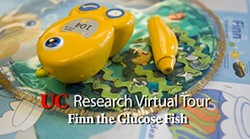
Take UC s New Research Virtual Tour: See Student Research with Real-World Results
University of Cincinnati students are part of an advanced workforce preparing for the global economy investing in the region, state and nation and, most of all, investing in themselves.
The depth and scope of the opportunities available for student research at UC is represented by the
just announced in terms of research funding for 2010:
$443 million
. UC ranks No. 25 in the nation among public research-intensive universities based on National Science Foundation data on federal research expenditures.
Learning opportunities beyond the classroom are exemplified in the six stops on UCs new
. You can take all the stops or just one.

Field Experience with Fossils
Stop one
(1:30)
Sara Oser has studied paleontology as an undergraduate at UC. Paleontology is the study of what fossils tell us about environments and ecologies of the past, and UCs paleontology program is ranked
No. 6
in the nation by U.S. News & World Report.
As a UC student, Sara conducted important field work in Cincinnati, in Montana and even as far away as Mongolia. For instance, at the Mothers Day dinosaur site in Montana, Sara carried out an independent project to
document the limb bones of sauropods
. In the process, she confirmed evidence to challenge the prevailing view that the site was a place where dinosaurs became mired in what was once a muddy, shrinking waterhole.
Stop two
Stop or Speed Through a Yellow Light
(2:33)
Engineering graduate student Zhixia Li has headed a real-world project that every driver can relate to. Its a project on which he has presented and published nationally and which has appeared in international news media, including The Washington Post, The Boston Globe and many others. Lis research looks at what he calls the yellow light dilemma. Are you, as a driver, more likely to stop or to speed through a yellow light? Certain factors make it more likely youll opt to speed through an intersection vs. stop at the light. These include lane position, type of vehicle, travel speed, speed limit and timing of the light.

Fishing for Answers
Stop three
(2:16)
Third-year doctoral student Rob Littleton uses the zebrafish to study life-threatening disease. This tiny research subject (about 1-2 millimeters as embryos and 3-4 centimeters full grown) develop so rapidly that the young have a beating heart 22 hours after the sperm and egg get together. Their speedy development and almost transparent bodies allow Littleton to visualize full organ systems under a microscope in real time. He uses this to his advantage by creating fluorescent fat deposits that he then introduces into the fish. In humans, this buildup is called atherosclerosis, and Littleton hopes to use the zebrafish model to test a holistic treatment for the life-threatening plaque accumulation that might one day be tested in humans.
Stop four
(3:01)
Theres no reason toys and medicine cant mix. So says UC industrial design student Samantha Gustafson whose design research innovation and study of juvenile diabetes has resulted in a unique glucose meter design for young children Finn the Glucose Fish. Its a project that has already won national attention.
Gustafsons design won her a $7,000 prize
from the California Health Association and a consulting/marketing session with IDEO, a prestigious global design and innovation firm.

Hard Water and Hard Science
Stop five
(2:07)
Fifty percent of consumers bleach their hair. Thats just one of the many things that cause damage. Fourth-year cosmetic science graduate student Amber Evans studies that damage. For instance, does the damaged hair take up more of the calcium and magnesium ions present in hard water? Shes observed that this could be the case. This kind of data is useful for scientists in the research and development field as they work to create new hair care products.
Stop six
Detecting Disease Using Nanoparticles
(2:09)
Last year, the threat of swine flu (influenza) closed schools throughout the country, and communities ramped up emergency-preparedness plans. For those who fell ill, for hospitals and physicians offices and for communities, the challenge was the time lag in accurately diagnosing seasonal flu vs. swine or bird flu. Currently, the most accurate method of testing, the viral culture, can take three to ten days to yield results. By then, the disease may have passed or already taken a life. UC chemistry graduate student Yun He is helping to lead a project to develop a new nanoparticle-based technique for the rapid detection of influenza viruses. The eventual goal of this project is a portable, commercial kit that health-care providers will be able to use in order to make a correct flu diagnosis within two hours.
- Take the 2010 Research Virtual Tour.
- Take the 2009 Research Virtual Tour.
- See UCs latest figures on research funding, at an all-time high of $443 million in fiscal year 2010.
- See the video of UC research projects presented at the Ohio Statehouse.
Related Stories
2024 Daniel Drake Medals to be awarded April 27
April 24, 2024
The UC College of Medicine will award three people with 2024 Daniel Drake Medals April 27.
UC education allowed couple to make mark on Cincinnati
April 24, 2024
As a native of Defiance, Ohio, John Deatrick, CEAS ’79, says arriving in Cincinnati to attend the University of Cincinnati in 1963 felt like landing in New York City.
Engineering student studying flight physics of birds
April 24, 2024
After earning a bachelor's degree in mechanical engineering in Nepal, Sameer Pokhrel came to the United States to further his education. From an early age, he had a lifelong fascination with aviation. As an adult, he transformed this fascination into a career, pursuing a doctoral degree in aerospace engineering at the University of Cincinnati's historic program. Here, he has succeeded in research, instruction, and was recently named Graduate Student Engineer of the Month by the College of Engineering and Applied Science.
